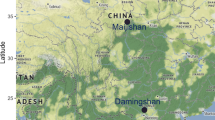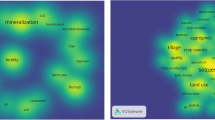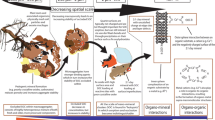Abstract
Background and Aims
Soil phosphorus (P) composition changes with ecosystem development, leading to changes in P bioavailability and ecosystem properties. Little is known, however, about how soil P transformations proceed with ecosystem development in boreal regions.
Methods
We used 1-dimensional 31P and 2-dimensional 1H, 31P correlation nuclear magnetic resonance (NMR) spectroscopy to characterise soil organic P transformations in humus horizons across a 7,800 year-old chronosequence in Västerbotten, northern Sweden.
Results
Total soil P concentration varied little along the chronosequence, but P compounds followed three trends. Firstly, the concentrations of DNA, 2-aminoethyl phosphonic acid, and polyphosphate, increased up to 1,200–2,700 years and then declined. Secondly, the abundances of α– and β—glycerophosphate, nucleotides, and pyrophosphate, were higher at the youngest site compared with all other sites. Lastly, concentrations of inositol hexakisphosphate fluctuated with site age. The largest changes in soil P composition tended to occur in young sites which also experience the largest shifts in plant community composition.
Conclusions
The apparent lack of change in total soil P is consistent with the youth and nitrogen limited nature of the Västerbotten chronosequence. Based on 2D NMR spectra, around 40 % of extractable soil organic P appeared to occur in live microbial cells. The observed trends in soil organic P may be related to shifts in plant community composition (and associated changes in soil microorganisms) along the studied chronosequence, but further studies are needed to confirm this.




Similar content being viewed by others
References
Alexandersson H, Karlström C and Larsson-McCann S (1991) Temperature and precipitation in Sweden 1961–1990: reference normals. In SMHI meteorology report SMHI, Norrköping
Bowman RA, Cole CV (1978) Transformations of organic phosphorus substrates in soils as evaluated by NaHCO3 extraction. Soil Sci 125:49–54
Cade-Menun BJ, Preston CM (1996) A comparison of soil extraction procedures for 31P NMR spectroscopy. Soil Sci 161:770–785
Celi L, Barberis E (2007) Abiotic reactions of inositol phosphates in soil. In: Turner BL, Richardson AE, Mullaney EJ (eds) Inositol phosphates: Linking agriculture and the environment. CAB International, Oxfordshire, pp 207–220
Condron LM, Turner BL, Cade-Menun J (2005) Chemistry and dynamics of soil organic phosphorus. In: Sims JT, Sharpley AN (eds) Phosphorus: Agriculture and the environment. American Society of Agronomy, Madison, pp 87–121
Crews TE, Kitayama K, Fownes JH, Riley RH, Herbert DA, Mueller-Dombois D, Vitousek PM (1995) Changes in soil phosphorus fractions and ecosystem dynamics across long chronosequence in Hawaii. Ecology 76:1407–1424
DeLong EF, Wickham GS, Pace NR (1989) Phylogenetic stains—Ribosomal RNA-based probes for the identification of single cells. Science 243:1360–1363
Doolette AL, Smernik RJ (2011) Soil organic phosphorus speciation using spectroscopic techniques. In: Bünemann EK, Oberson A, Frossard E (eds) Phosphorus in action: Biological processes in soil phosphorus cycling. Springer, Berlin Heidelberg, pp 3–36
Doolette AL, Smernik RJ, Dougherty WJ (2009) Spiking improved solution phosphorus-31 nuclear magnetic resonance identification of soil phosphorus compounds. Soil Sci Soc Am J 73:919–927
Ehretsmann CP, Carpousis AJ, Krisch HM (1992) FASEB J 6:3186–3192
Ericson K, Wallentinius HG (1979) Sea-shore vegetation around the Gulf of Bothnia: guide for the international society of vegetation science, July-August 1977. Wahlenbergia Scripta Botanica Umensia 5:1–142
Fang CM, Moncrieff JB (2005) The variation of soil microbial respiration with depth in relation to soil carbon composition. Plant Soil 268:243–253
FAO (1990) Guidelines for profile description. FAO, Rome, p 70
Frostegård A, Bååth E (1996) The use of phospholipid fatty acid analysis to estimate bacterial and fungal biomass in soil. Biol Fert Soils 22:59–65
Giesler R, Högberg M, Högberg P (1998) Soil chemistry and plants in Fennoscandian boreal forest as exemplified by a local gradient. Ecology 79:119–137
Giesler R, Ilvesniemi H, Nyberg L, van Hees P, Starr M, Bishop K, Kareinen T, Lundström US (2000) Distribution and mobilization of Al, Fe and Si in three podzolic soil profiles in relation to the humus layer. Geoderma 94:249–263
Giesler R, Petersson T, Högberg P (2002) Phosphorus limitation in boreal forests: effects of aluminum and iron accumulation in the humus layer. Ecosystems 5:300–314
Giesler R, Satoh F, Ilstedt U, Nordgren A (2004) Microbially available phosphorus in boreal forests: effects of aluminum and iron accumulation in the humus layer. Ecosystems 7:208–217
Giesler R, Andersson T, Lovgren L, Persson P (2005) Phosphate sorption in aluminum- and iron-rich humus soils. Soil Sci Soc Am J 69:77–86
Hawkes GE, Powlson DS, Randall EW, Tate KR (1984) A 31P nuclear magnetic resonance study of the phosphorus species in alkali extracts of soils from long-term field experiments. J Soil Sci 35:45–40
Hoffland E, Giesler R, Jongmans T, van Breemen N (2002) Increasing feldspar tunneling by fungi across a north Sweden podzol chronosequence. Ecosystems 5:11–22
Horiguchi M (1984) Occurrence, identification and properties of phosphonic and phosphinic acids. In: Hori T, Horiguchi M, Hayashi A (eds) Biochemistry of natural C-P compounds. Japanese Association for Research on the Biochemistry of C-P Compounds, Shiga, pp 24–52
Jersak J, Amundson R, Brimhall G (1995) A mass-balance analysis of podzolization—Examples from the northeastern United States. Geoderma 66:15–42
Kang J, Hesterberg D, Osmond DL (2009) Soil organic matter effects on phosphorus sorption: a path analysis. Soil Sci Soc Am J 73:360–366
Karlsson T, Persson P, Skyllberg U, Morth CM, Giesler R (2008) Characterization of iron(III) in organic soils using extended X-ray absorption fine structure spectroscopy. Environ Sci Technol 42:5449–5454
Karnahl U, Wasternack C (1992) Half-life of cytoplasmic rRNA and tRNA, of plastid rRNA and of uridine nucleotides in heterotrophically and photoorganotrophically grown cells of Euglena gracilis and its apoplastic mutant W3BU. Int J Biochem 24:493–497
Kemp PF, Lee S, LaRoche J (1993) Estimating the growth rate of slowly growing marine bacteria from RNA content. Appl Environ Microbiol 59:2594–2601
Kerkhof L, Ward BB (1993) Comparison of nucleic acid hybridization and flourometry for measurement of the relationship between RNA/DNA ratio and growth rate in a marine bacterium. Appl Environ Microbiol 59:1303–1309
Lagerström A, Esberg C, Wardle DA, Giesler R (2009) Soil phosphorus and microbial response to a long-term wildfire chronosequence in northern Sweden. Biogeochemistry 95:199–213
Land M, Ingri J, Ohlander B (1999) Past and present weathering rates in northern Sweden. Appl Geochem 14:761–774
Lipkin D, Talbert P, Cohn M (1954) The mechanism of the alkaline hydrolysis of ribonucleic acids. J Am Chem Soc 76:2871–2872
Makarov MI, Haumaier L, Zech W (2002a) The nature and origins of diester phosphates in soils: a P-31-NMR study. Biol Fert Soils 35:136–146
Makarov MI, Haumaier L, Zech W (2002b) Nature of soil organic phosphorus: an assessment of peak assignments in the diester region of P-31 NMR spectra. Soil Biol Biochem 34:1467–1477
Makarov MI, Haumaier L, Zech W, Marfenina OE, Lysak LV (2005) Can P-31 NMR spectroscopy be used to indicate the origins of soil organic phosphates? Soil Biol. Biochem 37:15–25
Mäkinen J, Mäkinen J, Ekman M, Midtsundstad Å, Remmer O (1986) The Fennoscandian land uplift gravity lines1966-1984. Rep Finn Geodesic Inst 85:4, 238
McDowell RW, Cade-Menun B, Stewart I (2007) Organic phosphorus speciation and pedogenesis: analysis by solution P-31 nuclear magnetic resonance spectroscopy. Eur J Soil Sci 58:1348–1357
Merilä P, Smolander A, Strommer R (2002a) Soil nitrogen transformations along a primary succession transect on the land-uplift coast in western Finland. Soil Biol Biochem 34:373–385
Merilä P, Strommer R, Fritze H (2002b) Soil microbial activity and community structure along a primary succession transect on the land-uplift coast in western Finland. Soil Biol Biochem 34:1647–1654
Merilä P, Malmivaara-Lamsa M, Spetz P, Stark S, Vierikko K, Derome J, Fritze H (2010) Soil organic matter quality as a link between microbial community structure and vegetation composition along a successional gradient in a boreal forest. Appl Soil Ecol 46:259–267
Muttray AF, Mohn WW (1999) Quantitation of the population size and metabolic activity of a resin acid degrading bacterium in activated sludge using slot-blot hybridization to measure the rRNA: rDNA ratio. Microb Ecol 38:348–357
Patil GP, Gore SD, Taillie C (2011) Composite sampling: A novel method to accomplish observational economy in environmental studies. Springer, New York
Peltzer DA, Wardle DA, Allison VJ, Baisden WT, Bardgett RD, Chadwick OA, Condron LM, Parfitt RL, Porder S, Richardson SJ, Turner BL, Vitousek PM, Walker J, Walker LR (2010) Understanding ecosystem retrogression. Ecol Monogr 80:509–529
Renberg I and Segerström U 1981 The initial points on a shoreline displacement curve for southern Västerbotten, dated by varve-counts of lake sediments. In Florilegium Xorinis dedicatum. Eds. L K Königsson and K Paabo. Stria, 14: 174–176. Uppsala
Rousk J, Bååth E (2011) Growth of saprotrophic fungi and bacteria in soil. FEMS Microbiol Ecol 78:17–30
Rustad LE, Cronan CS (1995) Biogeochemical controls on aluminum chemistry in the O-horizon of a red spruce (Picea rubens Sarg.) stand in Central Maine, USA. Biogeochemistry 29:107–129
Selmants PC, Hart SC (2010) Phosphorus and soil development: does the Walker and Syers model apply to semiarid ecosystems? Ecology 91:474–484
Soil Survey Staff 1992 Keys to soil taxonomy. In SMSS technical monograph. p. 556, Blacksburg (VA).
Starr M R 1991 Soil formation and fertility along a 5000 year chronosequence. In Environmental geochemistry in northern Europe. Ed. Pulkkinen. pp 99–104. Geological Survey of Finland Special Paper 9, 99–104
Stevens PR, Walker TW (1970) The chronosequence concept and soil formation. Q Rev Biol 45:333–350
Svensson JS, Jeglum JK (2000) Primary succession and dynamics of Norway spruce coastal forests on land-uplift ground moraine. Stud Forestalia Suecica 209
Svensson JS, Jeglum JK (2003a) Spatio-temporal properties of tree-species belts during primary succession on rising Gulf of Bothnia coastlines. Ann Bot Fenn 40:265–282
Svensson JS, Jeglum JK (2003b) Primary succession pathway of Norway spruce communities on land-uplift seashores. Ecoscience 10:96–109
Turner BL, Engelbrecht BMJ (2011) Soil organic phosphorus in lowland tropical rain forests. Biogeochemistry 103:297–315
Turner BL, Mahieu N, Condron LM (2003) Phosphorus-31 nuclear magnetic resonance spectral assignments of phosphorus compounds in soil NaOH-EDTA extracts. Soil Sci Soc Am J 67:497–510
Turner BL, Condron LM, Richardson SJ, Peltzer DA, Allison VJ (2007) Soil organic phosphorus transformations during pedogenesis. Ecosystems 10:1166–1181
Vestergren J, Vincent AG, Jansson M, Persson P, Istedt U, Grobner G, Giesler R, Schleucher J (2012) High-resolution characterization of organic phosphorus in soil extracts using 2D H-1-P-31 NMR correlation spectroscopy. Env Sci Tech 46:3950–3956
Vincent AG, Turner BL, Tanner EVJ (2010) Soil organic phosphorus dynamics following perturbation of litter cycling in a tropical moist forest. Eur J Soil Sci 61:48–57
Vincent AG, Schleucher J, Gröbner G, Vestergren J, Persson P, Jansson M, Giesler R (2012) Changes in organic phosphorus composition in boreal forest humus soils: the role of iron and aluminium. Biogeochemistry 108:485–499
Vitousek PM (2004) Nutrient cycling and limitation: Hawai’i as a model system. Princeton University Press, New Jersey
Vitousek PM, Farrington H (1997) Nutrient limitation and soil development: experimental test of a biogeochemical theory. Biogeochemistry 37:63–75
Walker TW, Syers JK (1976) The fate of phosphorus during pedogenesis. Geoderma 15:1–19
Wallander H, Morth CM, Giesler R (2009) Increasing abundance of soil fungi is a driver for (15)N enrichment in soil profiles along a chronosequence undergoing isostatic rebound in northern Sweden. Oecologia 160:87–96
Wardle DA, Walker LR, Bardgett RD (2004) Ecosystem properties and forest decline in contrasting long-term chronosequences. Science 305:509–513
Wood T, Borman F, Voigt GK (1984) Phosphorus cycling in a northern hardwood forest: biological and geochemical control. Science 223:391–393
Zackrisson O (1977) Influence of forest fires on the North Swedish boreal forest. Oikos 29:22–32
Acknowledgments
We are grateful to Leo Condron and to three anonymous reviewers for helpful comments on previous versions of this manuscript. Funding for this study was provided by the Kempe Foundation (AGV), the Swedish Research Council VR (JS, GG, RG, PP, MJ), the Swedish Research Council FORMAS (JS) and the Centre for Environmental Research in Umeå (CMF) (JV).
Author information
Authors and Affiliations
Corresponding author
Additional information
Section Editor's name: Hans Lambers.
Rights and permissions
About this article
Cite this article
Vincent, A.G., Vestergren, J., Gröbner, G. et al. Soil organic phosphorus transformations in a boreal forest chronosequence. Plant Soil 367, 149–162 (2013). https://doi.org/10.1007/s11104-013-1731-z
Received:
Accepted:
Published:
Issue Date:
DOI: https://doi.org/10.1007/s11104-013-1731-z




